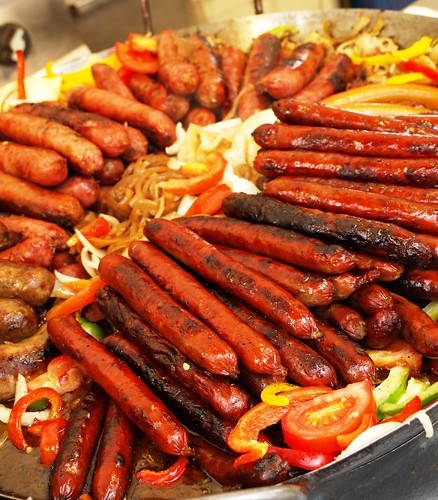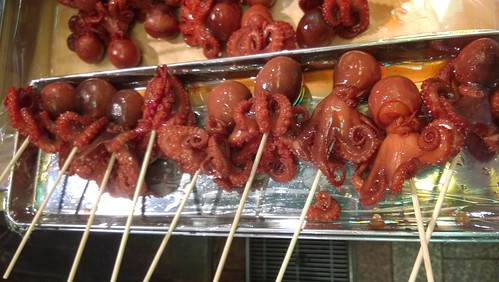More than Meats the Eye
Check out these barbecue foods images:
More than Meats the Eye

Image by joshbousel
Sausages

Image by antisocialtory
Vendanges de Montmartre
河原町周辺-錦市場

Image by Japanologia
I cannot describe all sensations I felt when I visited Kyoto for the first time in my life. That I have a special relationship with Japan, well, that’s no news. But Kyoto has this special energy, unbelievable and indescribable, that takes every visitor back in time to a distant past, and for many, a surreal past, as if we were displaced from the space-time continuum.
Kyoto was established in the 7th century in a land called Yamashiro-no-kuni by the Emperor Kammu. Strictly following the Chinese geomancy from the Tang Dinasty (you can see it in the city layout, the grid pattern and the disposition of squares and blocks), the feng shui guidelines and the natural protection offered by its surrounding mountains, Kyoto, formerly known as Heiankyō, was the second capital of Japan, preceded by Heijōkyō, Nara.
Strongly influenced by the Chinese culture, Buddhism, literature, music, dance, arts and laws, Kyoto experienced the Heian Period, considered by some as the apogee or epitome of nobility and court life. Known to this day as one of the largest centers of the high Japanese art, Kyoto is a city that still exudes grace, regardless of the district in which you are located.
If you want to get the best quality craft items or even meet other facets of Japanese cuisine, you definitely must go to Kyoto, a mandatory place to every visitor who lands on Japanese territory. About Japanese cuisine, well, I came to talk about a special place whose traditional shops are almost endless sources of ingredients not only for everyday life, but also for the best restaurants in town. Today I’ll talk about Kyoto’s Kitchen.
A few months ago I wrote an article about the gastronomic adventures of Jiro Taniguchi and Masayuki Kusumi in the amazing manga "Gourmet" (孤独のグルメ). As I wrote in that text, one of the best experiences you can have in Japan is to meet such a diverse and fantastically tasty cuisine, sometimes finding surprises in unexpected places that transcends that logic that “in Japan they only eat sushi, sashimi and Temaki”.
Again, for typical Japanese dishes, I’m talking about what you eat in the everyday life in the Land of the Rising Sun. No, not that stupidity to think that Japan was taken by temakis. Many of my friends are still surprised to learn that there are many more things than sushi and sashimi. One of the best places to understand, to feel, to smell and to taste this dimension of the Japanese daily life is going to the Nishiki Market or Nishiki Ichiba (錦市場), a magic place consisted by long and arrow blocks near the Teramachi Arcade (寺町通) and quite close to Pontochō (先斗町).
Its first traditional shops dates from the 14th century, becoming one of the most important fish suppliers of town. Nishiki Ichiba gradually turned into a big market, whose range of products includes not only food and ingredients for cooking, but also crafts, porcelain and other products for everyday life. Alongside the bric-a-brac shops, greengrocers, rice shops, fishmongers, pastry shops and ice cream parlors there are several restaurants serving typical food. At the end, the tour in Nishiki Ichiba can last for hours, filled with good food that is totally unknown to foreigners.
With its high ceilings and green, red and yellow glass tiles, Nishiki Ichiba is crowded with all kinds of people, all of them immersed in a world of infinite smells and tastes.
The first time I was in Nishiki Ichiba I was accompanied by the presence of great friends, one of them a resident of Kyoto in those times. Knowing every alley and city streets, she took us to one of the most impressive places of Kyoto, a market that fascinated me immediately. Come on, Japan is definitely not a place invaded by sushi-monsters, sashimi-zillas or temaki-robots.
It took years for me to return, this time paying attention to other details that go unnoticed that time. Initially being a profusion of signs for all the senses, now the Nishiki Ichiba was a very familiar place, whose tenants and Japanese buyers were all very kind, who did not hesitate to strike up a conversation with a stranger fascinated by Japanese culture. Despite being a tourist town, they showed enthusiasm in talking, in Japanese, to a japanologist researcher who felt back at home. For a short moment, everything seemed frozen in time. Or at least it seemed that time passed more slowly within that market. Worry less about sushi, temples, shrines and all that hightech mumbo jumbo and let be hooked by the stomach. Give it a try. I guarantee you it will be delicious.
by Victor Hugo Kebbe
Comments
Leave a Reply





